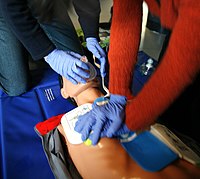
Assessing Documentation of Critical Imaging Result Follow-up Recommendations in Emergency Department Discharge Instructions
Sign Up to like & getrecommendations! Published in 2017 at "Journal of Digital Imaging"
DOI: 10.1007/s10278-017-0039-6
Abstract: To facilitate follow-up of critical test results across transitions in patient care settings, we implemented an electronic discharge module that enabled care providers to include follow-up recommendations in the discharge instructions. We assessed the impact… read more here.
Keywords: module; critical imaging; follow recommendations; discharge instructions ... See more keywords

Barriers to compliance with emergency department discharge instructions: lessons learned from patients’ perspectives
Sign Up to like & getrecommendations! Published in 2018 at "Internal and Emergency Medicine"
DOI: 10.1007/s11739-018-1943-6
Abstract: The objective of this study is to understand patients’ perspectives about system-based barriers that may influence decision-making regarding following discharge instructions. In this qualitative study, subjects were interviewed by phone 1–4 weeks following being discharged to… read more here.
Keywords: discharge instructions; barriers compliance; emergency department; discharge ... See more keywords

Patient Discharge Instructions in the Emergency Department and Their Effects on Comprehension and Recall of Discharge Instructions: A Systematic Review and Meta-analysis.
Sign Up to like & getrecommendations! Published in 2019 at "Annals of emergency medicine"
DOI: 10.1016/j.annemergmed.2019.06.008
Abstract: STUDY OBJECTIVE We conduct a systematic review with meta-analysis to provide an overview of the different manners of providing discharge instructions in the emergency department (ED) and to assess their effects on comprehension and recall… read more here.
Keywords: information; meta analysis; discharge instructions; discharge ... See more keywords

Patient experience with discharge instructions in postdischarge recovery: a qualitative study
Sign Up to like & getrecommendations! Published in 2017 at "BMJ Open"
DOI: 10.1136/bmjopen-2016-014842
Abstract: Objectives We examined the role of discharge instructions in postoperative recovery for patients undergoing colorectal surgery and report themes related to patient perceptions of discharge instructions and postdischarge experience. Design Semistructured interviews were conducted as… read more here.
Keywords: instructions postdischarge; recovery; discharge instructions; patient experience ... See more keywords

Guidelines: Discharge Instructions for Covid-19 Patients
Sign Up to like & getrecommendations! Published in 2021 at "Journal of Primary Care & Community Health"
DOI: 10.1177/21501327211024400
Abstract: Introduction/Objectives: Clinicians treating COVID-19 patients face a major challenge in providing an effective relationship with patients who are discharged to return to home in order to optimize patient self-management after discharge. The purpose of these… read more here.
Keywords: covid patients; discharge instructions; instructions covid; guidelines discharge ... See more keywords

Attitude of patients, healthcare professionals, and noninjured lay persons towards online video instructions on mild traumatic brain injury: a cross-sectional study
Sign Up to like & getrecommendations! Published in 2017 at "International Journal of Emergency Medicine"
DOI: 10.1186/s12245-017-0151-x
Abstract: BackgroundThe objective of this study was to determine the attitude of patients, healthcare professionals, and noninjured lay persons towards adding a video with discharge instructions to patient care for patients with mild traumatic brain injury… read more here.
Keywords: video; lay persons; discharge instructions; healthcare professionals ... See more keywords

Teach-Back Method: Using a Nursing Education Intervention to Improve Discharge Instructions on an Adult Oncology Unit.
Sign Up to like & getrecommendations! Published in 2019 at "Clinical journal of oncology nursing"
DOI: 10.1188/19.cjon.288-294
Abstract: BACKGROUND Transitions from acute clinical care to the outpatient setting can be daunting. Clear explanations of discharge instructions from nurses and assessment of the patient's understanding can have a positive impact. OBJECTIVES The purpose of… read more here.
Keywords: discharge instructions; intervention; education; back method ... See more keywords

Assessment of Readability, Understandability, and Completeness of Pediatric Hospital Medicine Discharge Instructions
Sign Up to like & getrecommendations! Published in 2017 at "Journal Of Hospital Medicine"
DOI: 10.12788/jhm.2688
Abstract: &NA; The average American adult reads at an 8th‐grade level. Discharge instructions written above this level might increase the risk of adverse outcomes for children as they transition from hospital to home. We conducted a… read more here.
Keywords: completeness; medicine; understandability; discharge instructions ... See more keywords

“We are doing it together”; The integral role of caregivers in a patients’ transition home from the medicine unit
Sign Up to like & getrecommendations! Published in 2018 at "PLoS ONE"
DOI: 10.1371/journal.pone.0197831
Abstract: Background An admission to hospital for acute illness can be difficult for patients and lead to high levels of anxiety. Patients are given a lot of information throughout their hospital stay and instructions at discharge… read more here.
Keywords: medicine; home; transition; discharge instructions ... See more keywords

Lights, Camera, Education in Action!: Creating video discharge instructions to improve patient and caretaker knowledge of concussions in the pediatric emergency department
Sign Up to like & getrecommendations! Published in 2020 at "Pediatrics"
DOI: 10.1542/peds.146.1_meetingabstract.26
Abstract: Background: From Instagram stories to viral YouTube clips, short and easily-shareable videos are now ubiquitous. By learning how to create like content, pediatric providers can better educate patients and caregivers on various diagnoses. Concussions frequently… read more here.
Keywords: emergency department; pediatric emergency; discharge instructions; video discharge ... See more keywords